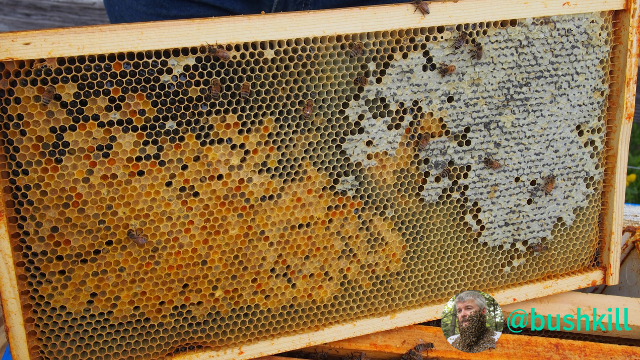New to the "Beekeeping for Everyone!" series?
Consider starting with Post #1, search #beekeepingforeveryone, or scroll to the bottom of this post for the complete list.
Let's talk Splits

Spring is quickly approaching for many of us in the northern hemisphere which means we will get to start working with our bees again.
Splits is a simple term that refers to talking a honeybee colony and splitting it into two or more colonies. It is the equivalent of a colony swarming, only this time initiated by the beekeeper. In fact, it is often done in an effort to prevent the bees from swarming. In this case it can be called 'artifical' swarms. Although there are many reasons to do splits, the most popular one is for colony increase and is often used to replace winter losses.
What you need to decide is if you will be purchasing a queen or queen cell from a commercial queen breeder or raising new queens from your own bees. Buying queens or queen cells allow you to bring new genetics and more diversity into your apiary. If purchased from a reputable breeder who searches out exceptional traits for their breeder stock, you can improve your own apiary genetics. Of course purchasing queens or queen cells is an expense, but often worth it. If you decided to raise your own queens, there are pitfalls that can be easily avoided, but often overlooked.
If you go back to the original introduction post, you will see where I talked about being a critical thinker. This is a perfect instance to practice. There are many methods of making splits that are done because they are either very easy, very cheap, or both. But in the long run they are not worth it. Remember, honeybees are survivors and will do whatever they can to survive. Just because they can make a replacement queen, does not make her a good queen. Beekeepers put a lot of faith in emergency queen cells, when in nature bees seldom do. I discussed my thoughts on emergency queens back in Honeybee Queens - part 1.
A very common method of splitting is called a walk away split because you simply split a hive into two hives and walk away. The theory is that the one split will have the old queen and continue on with a setback in population and most likely honey production. While the other split will be queenless and fall into that emergency situation and will raise a replacement queen from young larvae. I don't recommend this method because you can do so much better with just a little extra effort.
The commercial version of the walk away split is called yard trashing where you treat the whole bee yard as a resource pool and just makes splits by distributing the resources across as many colonies as you want to make. Like the simple walk away case some colonies will end up queenless and raise a new emergency queens, while others will end up with a queen. The difference in this case is that a queen may end up with bees from a different mother hive and may be killed which would then lead them to raise yet another emergency queen. Yard trashing use to be a popular method decades ago when bees where less challenged by the environment. Commercial beekeepers have since learned the value of good queens and either properly breed their own queens or purchase queens/cells. Commercial beekeepers have stopped relying on emergency queens, should you follow their lead?
What makes a good split
Obviously a good queen is key, but even the best queens can't thrive in poor conditions. You need to make sure the split has the proper resources. The minimal split would be a 5 frame nuc, unless you are looking to make queen mating nucs which is beyond the scope of this post and will be discussed at a later time. For this post let's focus on splits for increase. A five frame nuc will give the best chance of building up before winter and will take minimal resources from a strong mother hive. You should make the nuc from 2 frames of older brood (capped), two frames of pollen/honey and an empty frame for growth. In addition to the bees that are on the frames, it is a good practice to shake another frame of nurse bees into the nuc box. This is especially the case if the nuc will stay in the same yard as the mother hive to offset the field bees drifting back to the mother hive.

Now these are just rough suggestions and you will never find frames entirely brood. Just try to assemble frames that are equivalent to the suggestion. This layout will work equally well for introducing a new queen or giving them a queen cell. It will take a nuc given a queen cell longer to start to build as new brood will be two weeks or so behind a nuc given a new laying queen. I suggest never expecting a nuc to rear a queen cell from larvae, they just don't have the abundance of resources to make well fed queen cells. My next post will go through how to make splits rearing your own queens with Mel Disselkoen's OTS queen rearing method, which overcomes all the short comings of walk away splits with just slightly more effort.
Splits from Swarm Cells
So you go into your hive and find swarm cells, now what? First of all swarms cells are by far the best choice for rearing your own queens (See Honeybee Queens - part 1).
Rule #1
I CAN NOT emphasize this enough, if you can not find the mother queen you MUST assume that the hive has swarmed!

If you can find the queen, you can do an 'artificial' swarm in an attempt to prevent loosing a good portion of your bees to a feral situation. The key to this is that you must remove the mother queen to a nuc. A lot of folks will just remove or destroy the queen cells, but this will not break the swarm instinct. The only way to break it is to remove the mother queen, just as swarming would do. By taking the mother queen and some worker bees and putting them into a nuc you have given them a new home with reduced population, just as if they swarmed. Meanwhile the remaining bees in the original hive see a reduction in population and the loss of a queen as indication the hive has swarmed. This breaks the swarm impulse. If the hive is very strong, you can make additional splits as talked about above.
What if you can't find the queen?
Always leave at least one queen cell in the mother hive or you stand the risk of the hive becoming queenless. Just because there is still a large population of bees in the hive does not mean that they didn't swarm. Remember, a full frame of brood can account for 2 lbs of bees. A strong hive during spring build up can have a dozen or more frames of brood and the population explosion can easily overshadow a swarm leaving.


Beekeeping for Everyone! Series
Follow me (@bushkill) so you don't miss the next post in the Beekeeping for Everyone! series
Check out all the posts in the Beekeeping for Everyone! series
#1 - Introduction
#2 - The Importance of Pollinators
#3 - Honeybee Castes
#4 - Honeybee Queen - part 1
#5 - Honeybee Queen - part 2
#6 - Honeybee Worker
#7 - Honeybee Drone
#8 - There is Nothing Natural About Beekeeping!
#9 - Honeybee Nucs - Buyer Beware
#10 - Package Bees - Understanding What You'll Get

Talk Beekeeping

https://discord.gg/RwmvvFH

Keep On Keeping!
@bushkill
Just found you and am definitely following! I'm a few years away from becoming a beekeeper, but I might as well soak up knowledge in the meantime! Great post :)
The more you can learn before getting bees, the better it will be. There is so much to learn when people jump in feet first that it can be overwhelming. Make sure to check out the introductory post in the Beekeeping For Everyone series. I believe it discusses the most important piece of advice I can give. Be a critical thinker, to many people just do because that is what others told them to do.
Such a gorgeous photo of those beautiful queen cells @bushkill and a great article too. I kept bee s here in the UK for a few years and they are pretty divine creatures in their 'bee-ings' and honey being gold in colour, being a keeper of bees gives you the honour of tapping into their flow of gold into your life 😊
Interesting concept on the yard trashing method, its not something i had come across untill now. They say you learn something new every day.
Today i learnt more about bees.
Blessed are the bees 😊
And many blessings to you too
I have a dear friend in the UK, Roger Patterson, who is a education chairman for Bee Improvement and Bee Breeders Association in the UK. He has been trying to restore the native mellifera mellifera.
Did not know this! Very informative. Upvoted :)
love your post man, Always a lot of great info and photo's, greeting
Quite fascinating, this beekeeping! Thanks for sharing this post in Whaleshares and giving us a taste of your every life with the bees! 😊
Super informative! I live in the Philippines and would love to add some honey bees to my farm. I will go back to your intro and work my way to present. Thank you!
Daddy William
Good post friend
Please upvote me
We need all the honey bees we can get.
You have received an upvote from STAX. Thanks for being a member of the #steemsilvergold community and opting in (if you wish to be removed please follow the link). Please continue to support each other in this great community. To learn more about the #steemsilvergold community and STAX, check this out.
I'm trying to find one of your past posts for a friend. Didn't you have a post talking about harvesting swarms?
This one? -> https://steemit.com/homesteading/@bushkill/provide-shelter-for-the-homeless-and-save-the-world